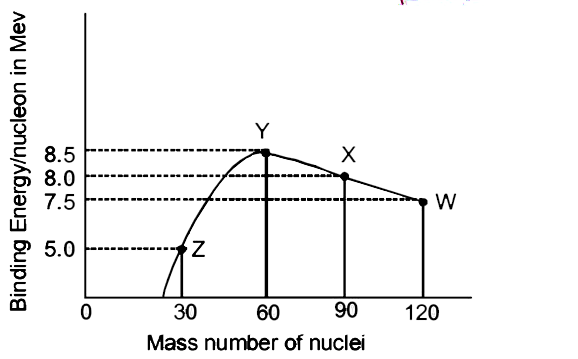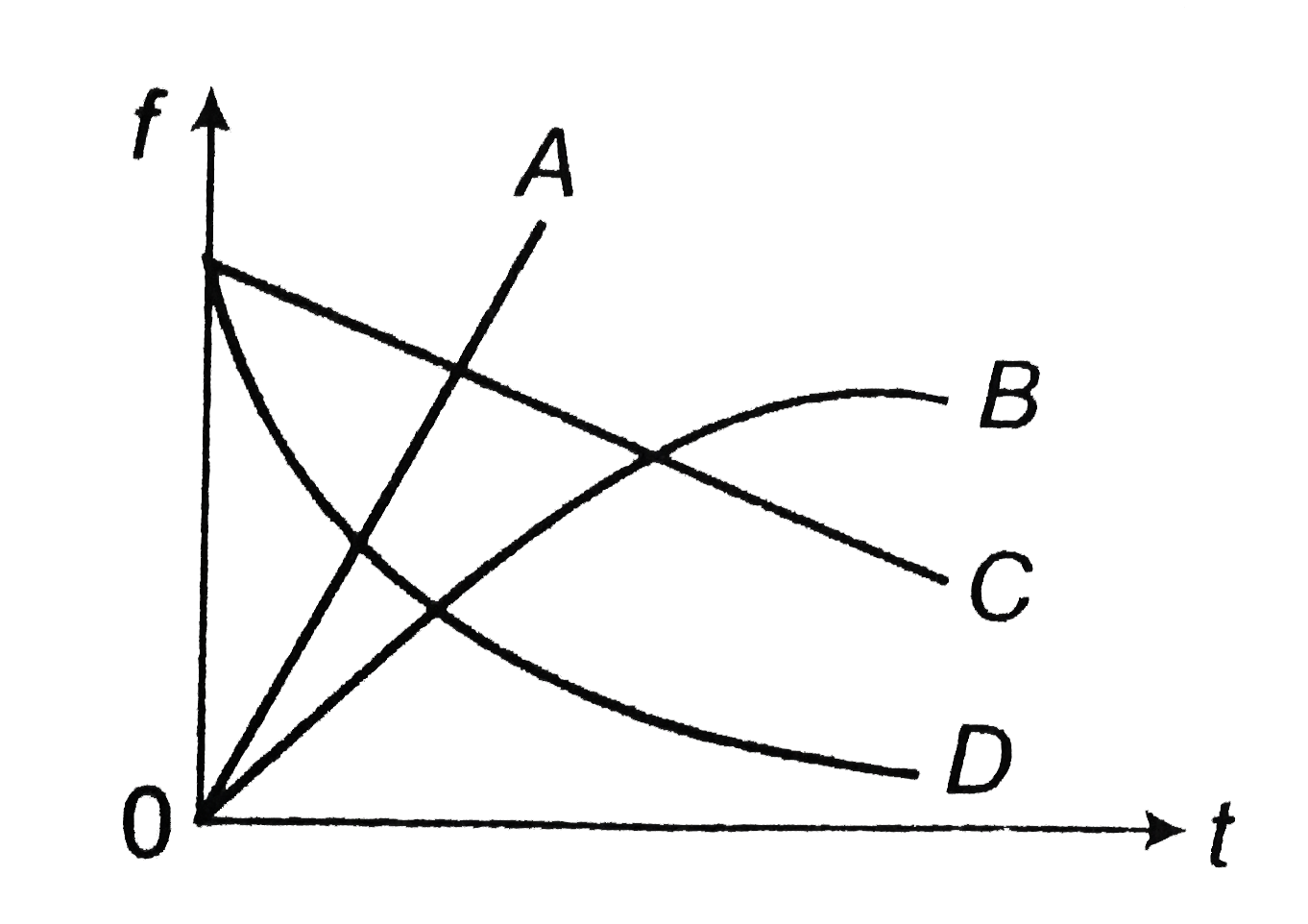Complete Solutions to Level-III of chapter NUCLEAR PHYSICS of Class 12 book with complete answers and questions
| Class 12 | PHYSICS |
| Chapter | NUCLEAR PHYSICS |
| NARAYANA | Level-III |
| Number Of Questions | 38 |
| Academic Year | 2023-24 |
`50%` of a radio active substance decays in `5` hours. The time required for the `87.5%` decays is
View Solution`4` grams of radioactive substance `A` left `1//2 gm` after some ture. `1` gran of another radioactive substance `B` left `1//4 gm` in the same period, If half life of `B` is `2` hours, the half life of `A` is ( in hours)
View SolutionOne mole of `alpha` emitter of half life equal to `2` days was placed in a sealed tube for `4` days at `S.T.P` volume of helium collector is
View Solution`3` ruthuerfords of a radio active isotope of half-life equal to `3` days was received after `12` days. Initial isotope packed was
View SolutionThe half life of a radio active substance is `6` hours. The amount of the substance undergone disintegration when `36 gms` of it undergoes decay for `18` hours is
View SolutionThe radio active nuclides `A` and `B` have half lives `t` and `2t` respectivey. If we start an experiment with one mole of each of them, the mole ratio after time interval of `6t` will be
View Solution`20%` of a radio active element disintergrates in `1` hr. The percentage of the radio active element disintergrated in `2` hrs will be
View SolutionThe `C^(14)` to `C^(12)` ratio in a certain piece of wood is `25%` of that in atmosphere. The half life period of `C^(14)` is `5,580` years. The age of wood piece is ( in years)
View SolutionA radioactive nucleus can decay by two different processes. The half-life for the first process is `t_1` and that for the second process is `t_2`. Show that the effective half-life `t` of the nucleus is given by
`1/t = 1/t_1 + 1/t_2`.
View SolutionThe age of the wood if only `1//16` part of original `C^(14)` is present in its piece is (in years) ( `T` of `C^(14)` is `5,580` years)
View SolutionA piece of wood is found to have the `(C^(14))/(C^(12))` ratio to be `0.5` times of that in a living plant The number of years back the plant died will be ( `T` of `C^(14)=5,580` years)
View SolutionA piece of wood collected from cro-Magnon caves gave `4` disintergrations`//`min. A freshly cut wood of the same weight gives `16` d.pm. The cro-magnon man lived about ( Half life of `C^(14)` is `5760` years. Assume the activity is due to `C^(14)` only)
View SolutionThe number of `U^(238)` nuclei in a rock sample equal to the number of `Pb^(206)` atoms. The half life of `U^(238)` is `4.5xx10^(9)` years. The age of the rock is
View SolutionEqual masses of two samples of charcoal `A and B` are burnt separately and the resulting carbon dioxide are collected in two vessels. The radioactivity of `^14 C` is measured for both the gas samples. The gas from the charcoal A gives `2100 counts` per week and the gas from the charcoal A gives 2100 counts per week and the gas from the charcoal `B` gives `1400` counts per week. Find the age difference between the two samples. Half-life of `^14 C = 5730 y`.
View SolutionThe half life of a radioactive substance is `20` minutes . The approximate time interval `(t_(2) - t_(1))` between the time `t_(2)` when `(2)/(3)` of it had decayed and time `t_(1)` when `(1)/(3)` of it had decay is
View SolutionA charged capacitor of capacitance C is discharged through a resistance R. A radioactive sample decays with an average-life `tau`.Find the value of R for which the ratio of the electrostatic field energy stored in the capacitor to the activity of the radioactive sample remains constant in time.
View SolutionUranium- `238` decays to thorium-`234` with half-life `5xx10^(9) yr`. The resulting nucleus is in the excited state and hence further emits `gamma`-rays to come to the ground state. It emits `20 gamma`-rays per second. The emission rate will drop to `5 gamma`-rays per second in
View SolutionA sample of radioactive material has mass `m`, decay constant `lambda`, and molecular weight `M`. Avogadro constant `=N_(A)`. The initial activity of the sample is:
View SolutionA radioactive sample has a mass m, decay cosntant `lambda`, and molecular weight M. If the Avogadro number is `N_A`, then
(a) find the initial number of neclei present, (b) find the number of deacyed nuceli after a time t, (c ) find the activity of the sample after a time t,
View SolutionIn moon rock sample the ratio of the number of stable argon-`40` atoms present to the number of radioactive potassium`-40` atoms is `7:1`. Assume that all the argon atoms were produced by the decay of potassium atoms, with a half-life of `2.5xx10^(9)yr`. The age of the rock is
View SolutionThe half-life of a radioactive sample is `T`. If the activities of the sample at time `t_(1)` and `t_(2)` `(t_(1) lt t_(2))` and `R_(1)` and `R_(2)` respectively, then the number of atoms disintergrated in time `t_(2)-t_(1)` is proportional to
View SolutionConsider a hypothetical annihilation of a stationary electron with a stationary positron. What is the wavelength of the resulting radiation?
View SolutionA radioactive nucleus can decay by two different processes. The half life for the first process is `2 t` and that for the second process is `t`. The effective disintergration constant of nucleus is
View SolutionA proton with kinetic energy `K`, strikes another proton at rest. If the collision is head-on, find the correct graph between `K` and the distance of closest approach, `r`.
View SolutionThe fraction quantity of a radiactive sample will decay during half of its half-life period is
View SolutionA small quantity of a solution containing `N^(24)` radio-nuclide of half-life `T` and activity `R_(0)` is injected into blood of a person. `1 cm^(3)` of sample of blood taken from the blood of the person shows activity `R_(1)`. If the total volume of the blood in the body of the person is `V`, find the timer after which sample is taken.
View SolutionA nucleus with mass number `220` initially at rest emits an `alpha`-particle. If the Q-value of the reaction is `5.5 MeV`, calculate the kinetic energy of the `alpha`-particle.
(a) 4.4 MeV (b) 5.4 MeV (c) 5.6 MeV (d) 6.5 MeV
View SolutionSome amount of a radioactice substance (half-life =10 days ) is spread inside a room and consequently the level of radiation become `50` times the permissible level for normal occupancy of the room. After how many days will the room be safe for occupation?.
View SolutionIn the options given below, let `E` denote the rest mass energy of a nucleus and `n` a neutron. The correct option is:
View SolutionFour different radioactive elements are kept in separated containers. In the beginning the container `A` has `200 g`-atom with half-life of `2` days, `B` has `20 g`-atom with half-life of `20` days, `C` has `2g`-atom with half-life `200` days and `D` has `100g`-atoms wityh half-life of `10` days. In the begining the maximum activity exhibited by the container is
View SolutionBinding energy per nucleons vs mass curve for nucleus is shown in the figure `W,X,Y`and `Z` are four nuclei indicated on the curve . The process that would release energy is

View SolutionWhen `_(3)Li^(7)` nuclei are bombarded by protons , and the resultant nuclei are `_(4)Be^(8)` , the emitted particle will be
View SolutionA sample of uranium is a mixture of three isotopes `._(92)U^(234), ._(92)U^(235)` and `._(92)U^(238)` present in the ratio `0.006%, 0.71%` and `99.284%` respectively. The half lives of then isotopes are `2.5xx10^(5)` years, `7.1xx10^(8)` years and `4.5xx10^(9)` years respectively. The contribution to activity (in `%`) of each isotope in the sample respectively
View SolutionThe table that follows shows some measurementf of the decay rate of a sample of `.^(128)I`, a radio nuclide often used medically as a tracer to measure the rate at which iodine is absorbed by the thyroid gland.
`|{:("Time(min)",A (counts//s),"Time(min)",A(counts)//s,),(4,392.2,132,10.9,),(36,161.4,164,4.56,),(68,65.5,196,1.86,),(10,26.8,218,1.00,):}|`

The half life `t_(1//2)` for this radio nuclide.
View SolutionThe fraction `f` of radioactive material that has decayed in time `t`, varies with time `t`. The correct variation id given by the curve.
 .
.
View SolutionThe rate of decay `(R )` of nuclei in a radioactive sample is plotted against time `(t)`. Which of the following best represents the resulting curve ?
View SolutionWhat is the probability of a radioactive nucleus to survive one mean life?
View SolutionA radioactive isotope is being produced at a constant rate `dN//dt=R` in an experiment. The isotope has a half-life `t_(1//2)`.Show that after a time `t gtgt t_(1//2)`,the number of active nuclei will become constant. Find the value of this constant.
View Solution
Level-III questions and complete solutions for chapter NUCLEAR PHYSICS of NARAYANA PHYSICS (HINGLISH) of Class 12